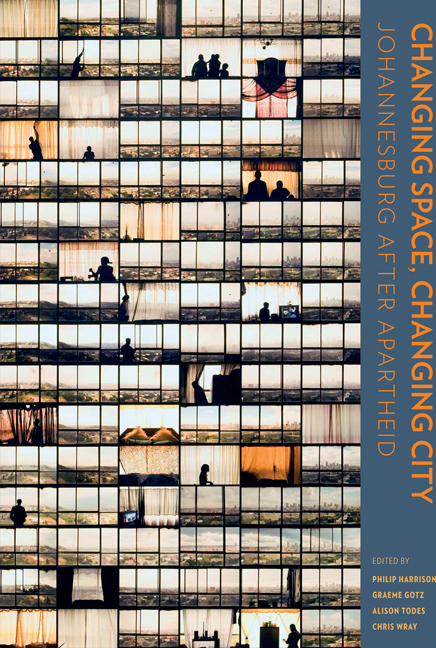Book contents
- Frontmatter
- Contents
- Preface
- Cartography
- 1 Materialities, subjectivities and spatial transformation in Johannesburg
- Section A The macro trends
- Section B Area-based transformations
- Section C Spatial identities
- 23 Footprints of Islam in Johannesburg
- 24 Being an immigrant and facing uncertainty in Johannesburg: The case of Somalis
- 25 On ‘spaces of hope’: Exploring Hillbrow's discursive credoscapes
- 26 The Central Methodist Church
- 27 The Ethiopian Quarter
- 28 Urban collage: Yeoville
- 29 Phantoms of the past, spectres of the present: Chinese space in Johannesburg
- 30 The notice
- 31 Inner-city street traders: Legality and spatial practice
- 32 Waste pickers/informal recyclers
- 33 The fear of others: Responses to crime and urban transformation in Johannesburg
- 34 Black urban, black research: Why understanding space and identity in South Africa still matters
- Contributors
- Photographic credits
- Acronyms
- List of plates
- List of figures
- List of tables
- Index
27 - The Ethiopian Quarter
from Section C - Spatial identities
Published online by Cambridge University Press: 20 April 2018
- Frontmatter
- Contents
- Preface
- Cartography
- 1 Materialities, subjectivities and spatial transformation in Johannesburg
- Section A The macro trends
- Section B Area-based transformations
- Section C Spatial identities
- 23 Footprints of Islam in Johannesburg
- 24 Being an immigrant and facing uncertainty in Johannesburg: The case of Somalis
- 25 On ‘spaces of hope’: Exploring Hillbrow's discursive credoscapes
- 26 The Central Methodist Church
- 27 The Ethiopian Quarter
- 28 Urban collage: Yeoville
- 29 Phantoms of the past, spectres of the present: Chinese space in Johannesburg
- 30 The notice
- 31 Inner-city street traders: Legality and spatial practice
- 32 Waste pickers/informal recyclers
- 33 The fear of others: Responses to crime and urban transformation in Johannesburg
- 34 Black urban, black research: Why understanding space and identity in South Africa still matters
- Contributors
- Photographic credits
- Acronyms
- List of plates
- List of figures
- List of tables
- Index
Summary
In a bunna bet, talk is interspersed with silence and reflection. The coffee maker works between the table of empty cups, the fuel of the fire and the aroma of coffee and incense that permeates the room. She alternates visual checks with serving gestures, preparing the space to support interaction, fuelling encounters with caffeine, and creating a place like home. Her labour links this space to Ethiopia. In Jeppe.
Jeppe is in Johannesburg. Four city blocks condense the energy of the city and its flows into a sort of substance that is an intensification of its essential exchanges, moralities and demographics. The bunna bet presents a quiet moment in this urban swirl. You stumble out from a world of silent tasting, abuzz with caffeine, onto streets infused with visual and aural energy. Sound systems and bright displays of clothes and mannequins compete for the attention of customers. Customers and porters squeeze through the space between pavement stalls and shopfronts, lugging parcels of goods from vans or to the taxi ranks and stations to the north.
Since my first visit to this bunna bet in Joburg Mall, above Bree Street, I have been back to Jeppe quite oft en and never found it the same. The density and mood on the street fluctuates in response to the supply of goods and the threats of raids. New bunna bets come and go. The area grows, block by block. Moving upwards and inwards from the pavement, outwards from the intersection of Jeppe and Delvers streets, and into every lost space within the densest areas. Jeppe is more like an organism than a place. People produce this space through gestures and negotiations that revolve around the materiality of the buildings and the goods that they trade, as well as the immaterial connections that mark the trail of their translocated lives and assets.
Jeppe has convinced me and others of the inadequacy of the ways in which we describe and work in the city. From time to time I climb up, via rooftops and through the medium of mapping, to observe and outline the area. But more frequently I get lost in its interior, seeking contact with people beyond the thresholds of its thick commercial edge.
- Type
- Chapter
- Information
- Changing Space, Changing CityJohannesburg after apartheid, pp. 498 - 505Publisher: Wits University PressPrint publication year: 2014



